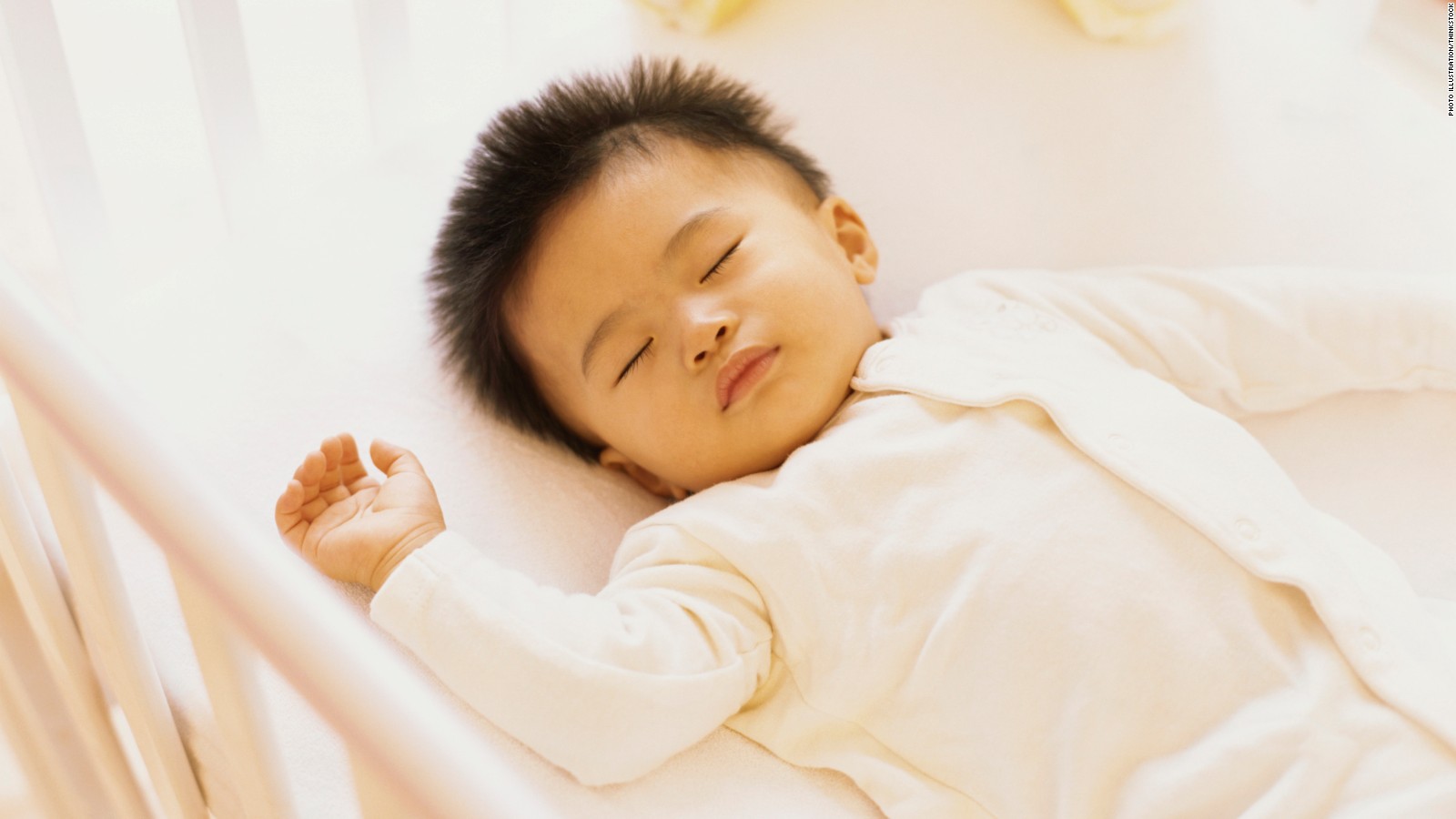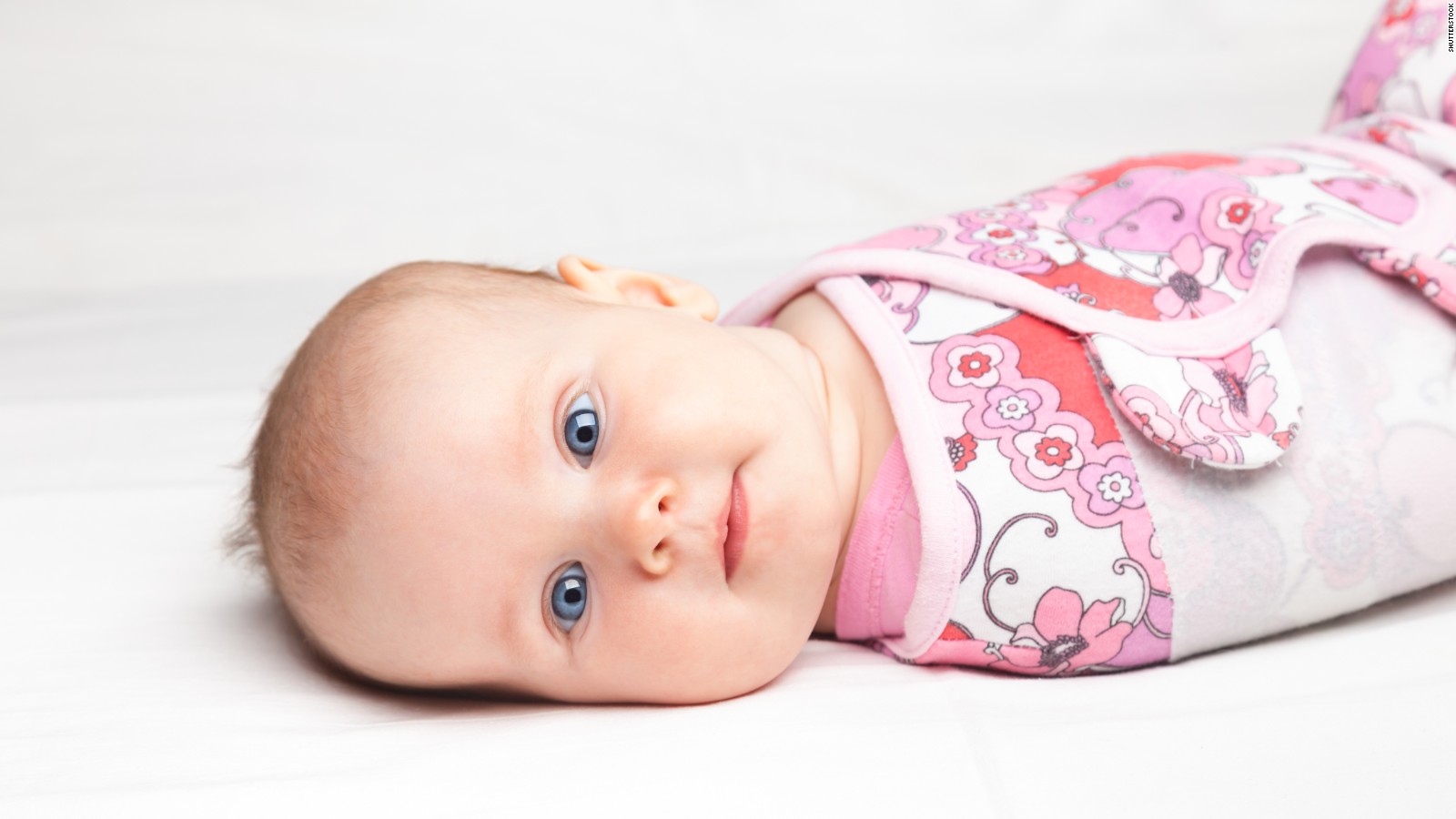Does Baby Have to Sleep on Flat Back
Story highlights
- Baby sleep is best if you play loud, rumbly white dissonance during all naps and nights
- An unswaddled baby can roll to an unsafe position more easily than a swaddled one
(CNN)We need more training to go a driver'south license than to become a parent, in our culture. Fifty-fifty though we would benefit from parental education, some of usa have never fifty-fifty held a newborn before having i of our own. And nosotros oftentimes rely on advice from friends and family, much of it outdated or just manifestly incorrect.
When it comes to infant sleep, bad communication can exist unsafe. Oct is Safe Slumber Awareness month, an opportunity to learn more than nearly sudden unexpected babe death and debunk the myths about what is sabotaging your sleep and highlight habits that potentially gamble your baby's safety.
Myth i: Your baby sleeps best in a silent room.
Not true. In fact, total silence can brand it difficult for your baby to doze off. Think, the womb is noisy: louder than a vacuum cleaner and running 24 hours a twenty-four hours. For nine months, your picayune one'south been lulled to sleep by the rhythmic whooshing of the claret flowing through the placenta. To her, the quiet of the average dwelling house is jarring. Plus, in a silent room, she's more than likely to wake up when a loud truck on the street or whatsoever other bump in the night breaks that silence. The truth is, your infant will sleep best if you play loud, rumbly white noise during all naps and nights.
Myth 2: You lot should never wake a sleeping baby.
Nope. You should always wake your sleeping babe using a little technique called "wake and sleep." Information technology gently teaches your child the important skill of self-soothing. Here's briefly how information technology works: Starting equally early on as the first day of life, wake him upward the tiniest flake subsequently sliding him into bed. Just tickle his cervix or anxiety until his eyes drowsily open up. Very shortly after, he'll migrate right dorsum into slumberland. In those few semi-awake seconds, he'due south just soothed himself back to sleep -- the first stride toward sleeping through the night.
Myth three: Some babies sleep worse when swaddled because they desire to exist free.
Not really. Your baby may fuss and resist swaddling at starting time, then it may look like she hates it. But babies don't demand freedom, they need the feeling of security they had in the womb. Without wrapping, your babe will flail her arms, whack herself in the face up and startle easily throughout the nighttime. That's a recipe for poor sleep.
Swaddling is the beginning step to calming, and it'southward of import yous don't stop at that place, peculiarly if your infant's been fighting it. To assist her settle, you'll want to layer in other womb-mimicking steps: "shushing," side/tummy position, swinging and sucking, which, along with swaddling, make up the v Due south's of setting up a babe for sleep success. And once the South's become function of your slumber routine, she'll give up her battle! (Notation: Side/tummy position is for calming only, never for sleep.)
Myth 4: We should teach babies to slumber in their ain rooms.
Having our babies grow upwards to exist independent takes a long time. In that location'due south no demand to rush it. In fact, having your new child slumber in another room is inconvenient (for feedings and diaper changes) and possibly dangerous. The American Academy of Pediatrics recommends that babies slumber in the parent'due south room for at least half-dozen months (always on their back, in their own bed). The elementary do has shown to significantly reduce the rate of sudden babe death syndrome.
Myth 5: Swaddling should exist stopped later on 2 months.
Swaddling reduces crying and increases sleep. Merely new inquiry shows that swaddled babies who scroll to the breadbasket have double the adventure of SIDS compared with an unswaddled babe rolling over. Equally a result, the pediatrics academy is now recommending that parents stop infant-wrapping at two months. On the face of information technology, the group's new advice seems to make sense, just information technology completely ignores the risks of not swaddling.
In an eight-twelvemonth review of information nerveless by the Consumer Product Safety Commission, only 22 sudden unexplained infant deaths related to swaddling were reported; almost 50% were in sleep sacks (a wear blanket), and 90% were found on the breadbasket and/or with bulky bedding. (Annotation: Fatalities categorized as sudden unexplained infant death include sleep deaths from accidental suffocation, strangulation and SIDS.)
During those eight years, hundreds of thousands -- if not millions -- of babies were swaddled. Since sudden unexplained infant death strikes one in one,200 babies, i would have expected hundreds or perhaps thousands of swaddle-related deaths over this period if wrapping caused these deaths. Of note, during the same viii years, 1,026 deaths related to sofa sleeping were reported to the safety commission.
The point is, though swaddling may introduce a theoretical risk, there is non a lot of proof it is causing a true increase in sudden unexplained baby decease. On the other hand, swaddling has been shown to reduce babe crying and boost sleep. That is of critical importance because the stress provoked by persistent fussing and parental burnout is a potent trigger for postpartum depression, child abuse, car accidents and even risky sleeping practices, which are associated with up to 70% of all infant sleep fatalities.
Nosotros don't want babies rolling over swaddled, just we likewise don't desire them rolling over unswaddled during the 2- to 4-calendar month-old elevation flow for SIDS. An unswaddled babe can curl to an unsafe position more easily than one whose move is restricted past snug swaddling. And, since swaddling improves sleep, unwrapped babies wake more frequently and are more probable to tempt their tired parents to autumn asleep with them in their beds.
To solve this tricky problem, I assembled a team of MIT-trained engineers and renowned industrial designer Yves Behar to invent a type of swaddle that keeps sleeping babies safely on the dorsum. In October 2016, my visitor Happiest Baby debuted Snoo, the globe's start responsive bassinet that employs this special swaddle, which clips to the base of the bed to forestall rolling. This innovation allows parents to reap the substantial benefits of swaddling for a full half-dozen months without any of the risks.
Myth 6: Putting babies to sleep on the back has solved SIDS.
The National Institute of Health-led Back to Sleep entrada apace reduced sleep deaths from 5,500 in 1994 to three,500 in 1999. Still, for the by 17 years, progress has completely stalled. The tragic truth is that three,500 infants die during their slumber each and ever yr. Although more babies are sleeping on the back, the rate of adventitious suffocation and strangulation infant deaths has quadrupled since the mid-1990s. What's behind this alarming trend? Unsafe sleeping practices. 70 percent of all sudden unexplained infant death victims are institute in adult beds, sofas and other risky locations.
A recent report revealed that while most parents fully plan to follow the ABCs of safe sleep (Alone, on the Back, in a Crib), less than half actually practice it. And by the finish of the night, nearly 60% of babies take migrated from their bassinet to their parents' bed, co-ordinate to a study in the Periodical of Clinical Lactation.
The terrible, unintended effect of the Back to Sleep campaign is that it has worsened baby sleep. Babies but don't slumber well on their backs in still, quiet cribs. And every bit discussed in myth 5, when babies don't sleep well, parents resort to bed-sharing, which leads to many more than baby suffocation deaths.
It is very important that parents continue to place their babies to sleep on the back, only they also demand to kickoff using more tools to meliorate their child's sleep. The adept news is that in that location are three effective means to boost slumber for back-sleeping babies: audio, swaddling and rocking.
Rumbly white dissonance is inexpensive and very effective for improving a baby'due south sleep. Snug swaddling is also, only as explained above, pediatricians now recommend that parents end wrapping at 2 months old. Motility, or swinging, is also great, just the American University of Pediatrics has plant that sleeping in sitting devices, such as rockers and swings, may permit a infant'due south head to coil forrard and cause adventitious suffocation and decease.
These are issues we sought to accost with the Snoo bed. Information technology allows for prophylactic swinging (it is totally flat), rubber swaddling (the baby tin't curl over) and safe sound, as the sound increases when a baby cries but then immediately softens -- after the baby calms -- for all-night sleep promotion. Nosotros designed information technology to deliver the right level of womb-similar stimulation that is right for any item babe to calm his or her fussing and boost sleep.
For nearly xx years, despite enormous public health educational programs, nosotros take failed to reduce infant slumber expiry. Simply, by focusing on sleep efficacy (boosting a baby's sleep), we at present take a very exciting means to preclude many -- if not almost -- of these deaths. And equally a wellness bonus, improving sleep efficacy may besides let the states to reduce other serious and unsolved health problems triggered by exhaustion and crying, such as postpartum depression (with well-nigh a half million cases diagnosed a yr) and shaken-baby syndrome (1,300 incidents a yr).
Delight join me in October -- and all year long -- by telling new parents nearly exhaustion'due south role in sudden unexplained babe death and by sharing the slumber-boosting tips mentioned hither. I am confident that we volition dramatically amend the health of American parents and babies as we put more energy and emphasis on helping parents promote better baby sleep.
Does Baby Have to Sleep on Flat Back
Source: https://www.cnn.com/2017/10/30/health/baby-sleep-myths/index.html





